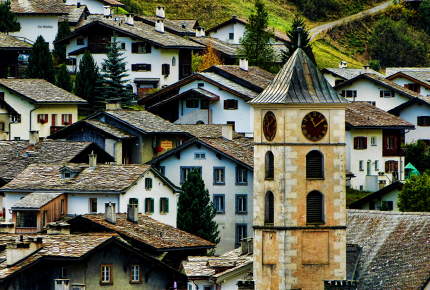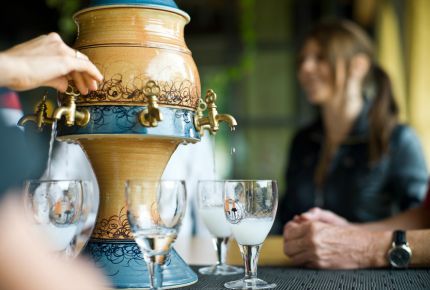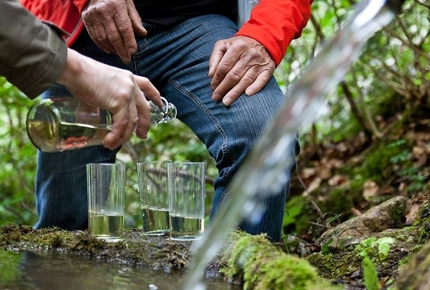Absinthe: Collected notes on a mind-altering drink
100 years ago, absinthe was banned across much of Europe. Daniel Fahey heads to its birthplace, Val-de-Travers in Switzerland, for a taste of its underground distillation scene.
Editor's Note:
We sent Daniel Fahey to Val-de-Travers in Switzerland to expose its clandestine absinthe scene, but received only the following: an A4 envelope stuffed with notes, quotes and recorded ramblings. Now we have word that he is safe, we've assembled this story from his original work and Dictaphone recordings. It begins with an apology written on a bar bill.
The Editor
C,
The hour is long, the valley dark, and rational thought escapes me. I cannot sleep yet continue to dream. I fear for my eternity. This envelope contains my findings from the last 48 hours, my assignment in full. Sorry it’s not typed, nor ordered, but use what you can. Adjust payment accordingly, and send on to my mother. I wish to walk back to England.
D
---
Couvet is an average Swiss town with very little remarkable about it. Scattered on the sod of the Val-de-Travers valley, 15km (9 miles) from the French border, its chalets stand in silence. It has a butchers, a cinema and a couple of bars. Cheery locals offer bonjour as they pass.
It is one of a string of towns sown across the valley that follow L'Areuse, a river that runs from west to east. More accurately, L'Areuse saunters, and is often the only evening noise, save the soft rush of frontier traffic from Road 10, which funnels French commuters between their beds and the canton's capital, Neuchâtel.
From the outside, you wouldn’t know that Couvet was home to the biggest bootleggers in Europe. Only one discreet distinction gives it away: the faint fragrance of anise.
---
It’s Sunday. I can hear a choir harmonising among the pines of Areuse Gorges, their refrain climbing upstream. I pause to listen but every time I stop, they do too.
---
Of yesterday afternoon: rested at a heavy, wooden table in a stone 18th-century dining room, I observe absinthe, fresh from the still, being poured from a wicker-covered bottle. It trickles into my glass, rising toward a 2cl mark. Water drips from a porcelain fountain, clouding the liquid into a milky cream colour.
Only a dust-smudged window welcomes July’s sun as I savour a sip. It’s smooth with a strong aftertaste of aniseed.
 A quaint alpine village: not the typical bootlegger hangout
A quaint alpine village: not the typical bootlegger hangoutCreative Commons / Mariano Mantel
“Do you like?” asks its distiller Philippe, adding water to his own glass.
I express that I do: “Much better than the stuff I had in the Czech Republic.”
Are Philippe and my guide Christine scoffing?
“Of course it is!” Christine interrupts, confirming they are. “You wouldn’t say ‘it’s better than the stuff I had in India’ if you were tasting a whisky in Scotland.”
---
Few hangovers compare to Jean Lanfray's last. Not even mine, which has me laid out winded across a wooden breakfast table of the Hôtel de l'Aigle in Couvet. I know that if I syrup my coffee with enough sugar, my pancreas will stop producing insulin, and I’ll feel human after lunch. Lanfray will remain a monster forever.
It was the absinthe what done it, or so the Swiss press had people believe when the French labourer picked up a rifle at his Commugny home and shot his wife through the forehead.
It was the absinthe what done it when he blasted his four-year-old daughter, Rose, too. So it must have been the absinthe when he levelled the barrel at Blanche, his two-year-old angel, and squeezed the trigger.
Newspaper bluster dubbed the killings ‘the Absinthe Murders’, despite Lanfray drinking just two absinthes on 28 August 1905. Reports differ, but he could have also sunk as much as two brandy coffees, six cognacs, seven glasses of wine, plus an extra litre of vino at home.
For temperance foundations, the timing couldn't have been better. They were pressuring politicians to ban alcohol, while French wine producers (smarting from a phylloxera outbreak that wiped out recent crops) wanted rid of absinthe too as it nibbled into their profits.
In the end, yellow-bellied Lanfray hung himself in his cell, but the case drew enough attention in Switzerland for the country to hold a referendum and ban the production and distribution of absinthe in 1910.
---
4.47pm: “I’ll get you some bread,” says Montserrat Kassamakov, the slight Spanish sprite working at Maison de L'Absinthe in Môtiers. Evidently I’m unsteady – either on foot or thought.
She pours me a verte (green), an Absinthe Bovert 77, presented with silver slotted spoon and square of sugar for snow-cold water to sieve through. Again, it’s enjoyable, with a liquorice bite. I have a dinner appointment with Christine, so empty my glass more eagerly than I should.
---
10.32pm: Hasty waiting staff swiftly clear the terrace tables. The unexpected rain, hot and impatient, raps on the cream parasols, lifting the volume of conversation in the restaurant.
The next table stop swiping their phones. Can they tell I’m drunk? They glare my way. Dessert comes with an unmarked elixir of life bottle. It’s absinthe. Christine drenches my vanilla ice cream with it. Seems strong; may need to walk home.
---
As with all such fashions, the rise of absinthe depended on a number of factors, in this case social acceptance and the drink’s salutary abilities.
Absinthe’s aesthetics (the crystal glass, the china saucer, the fancy fountain, the spoon, the drip, the sugar) helped it gain acceptance in high society, especially with ladies.
Montserrat Kassamakov from Maison de L'Absinthe: “It's thanks to absinthe that women started to go to cafés and bistros and restaurants. […] It allowed women to drink and have a social life. Before, it was only the prostitutes and low-level people who were drinking in public.” Later, advertised as a cure all, French soldiers packed absinthe into their kitbags as they headed to Africa. They used it to prevent cholera, dysentery and malaria.
---
The world was once too drunk to record where absinthe was invented, but locals insist it was in this valley. Common and Roman wormwood, hyssop, lemon balm and peppermint, the key aromatic plants for the spirit, all grow naturally here.
 Absinthe became very popular with the higher classes
Absinthe became very popular with the higher classes
Creative Commons / Saveurs
“Before the ban,” glows Philippe Martin, leading me from a dank drying attic onto a sun-faded balcony, “all those fields there, between the two villages, were full of wormwood.”
Two claims to its creation circulate: 1) Pierre Ordinaire, a deserter from the French army, had an absinthe recipe with him as he crossed into Switzerland in 1768; 2) Madame Henriod, a Couvet herbalist who mixed medicinal miracles, put absinthe into her teas from at least 1765.
New evidence suggests the drink was conceived before both.
Philippe Martin: “There was already a distillery working in 1761, which means the two other stories become…[trails off]. We can imagine the real start of absinthe was in Couvert between 1720 and 1740.”
---
To ponder: was absinthe as muse the world’s greatest marketing ploy?
For generations, poets and artists and absinthe became inseparable: Rimbaud used it to destroy his senses; Picasso painted its imbibers; Toulouse-Lautrec secreted his in a hollowed out cane; Verlaine hid a bottle of it beneath his deathbed pillow.
Soak the liver sufficiently and its owner would hallucinate: Wilde saw flowers; Van Gogh mixed rich yellows. But were images of floating fairies and uninhibited imaginings just the publicising of a product?
---
Thujone, a compound in woodworm, was long thought to be responsible for absinthe’s psychedelic properties, but recent studies have proved otherwise.
The American Chemical Society found that the concentrations of thujone, fenchone, pinocamphone, methanol and copper in pre-ban absinthe weren’t high enough to trigger hallucinations.
“All things considered, nothing besides ethanol was found in the absinthes that was able to explain the syndrome ‘absinthism’,” they concluded.
Philippe Martin: “There was a student from Neuchâtel, when the absinthe was re-legalised, who [analysed some absinthe and] said you must drink 60 absinthe per day [...] to have some issues with your brain. I'm not a doctor, but I imagine with 60 absinthes per day you're going to have some other issues.”
Estimates suggest that poets and painters would drink up to 12-20 glasses a day.
---
Few see absinthe as essential to existence, but for Val-de-Travers, it was. When the midnight bells rang its ban into force on 7 October 1910, locals were already hiding their stills.
Around 500 people in the valley relied on the spirit as their main income: either working the fields or distilling the drink. That’s why, by the end of that October, 120-150 clandestine distillers were already making moonshine.
“My father started in 1972,” Philippe Martin recalls, telling how his dad put wood across the bathtub and a still on top. “It was 10 or 12 litres per distillation, really small production, but he used to work in Neuchâtel and people used to say 'Ah! You're from Val-de-Travers, could you bring me some absinthe?'”
While Philippe’s father would secretly shift the odd bottle or two, others were running more professional outfits. Absinthe was moved worldwide in unopened pineapple tins or sold at the Post Office disguised in telephone boxes.
 Hikers mix Absinthe with spring water
Hikers mix Absinthe with spring waterRoute de l'Absinthe
Naturally, raids were made and stills confiscated, but the fines imposed varied depending on whether the alcohol had been bought in Switzerland.
One lady, caught distilling absinthe three times, received a fine of 16,000 CHF because she could prove she’d bought the pure alcohol in the country. Those shipping booze in from across the border are still paying fines off today.
---
“The fairy would put a bottle for walkers near fountains.”
Nicolas Giger and I are sauntering along a flinty hiking trail near the mouth of Gorges de la Pouetta-Raisse and he is talking about his favourite tipple, absinthe.
A clandestine distiller himself, and the founder of the Absinthe Trail (a route of distilleries, drying sheds and smuggling locations that runs from Pontarlier in France to just beyond Noiraigue in Switzerland), Giger is talking about an old prohibition tradition.
Thirsty locals would conceal bottles of la bleue absinthe in the forest, away from interfering eyes. They’d always be hidden near cold natural springs for absinthe admirers to unearth.
We share a glass at Fontaine à Louis, where we find a bottle buried behind a little wooden door.
Editor's Note:
The remainder of Daniel’s notes are either irrelevant, inappropriate or illegible.
The Editor
NEED TO KNOW
Do you have any Feedback about this page?
© 2025 Columbus Travel Media Ltd. All rights reserved. No part of this site may be reproduced without our written permission, click here for information on Columbus Content Solutions.









 You know where
You know where